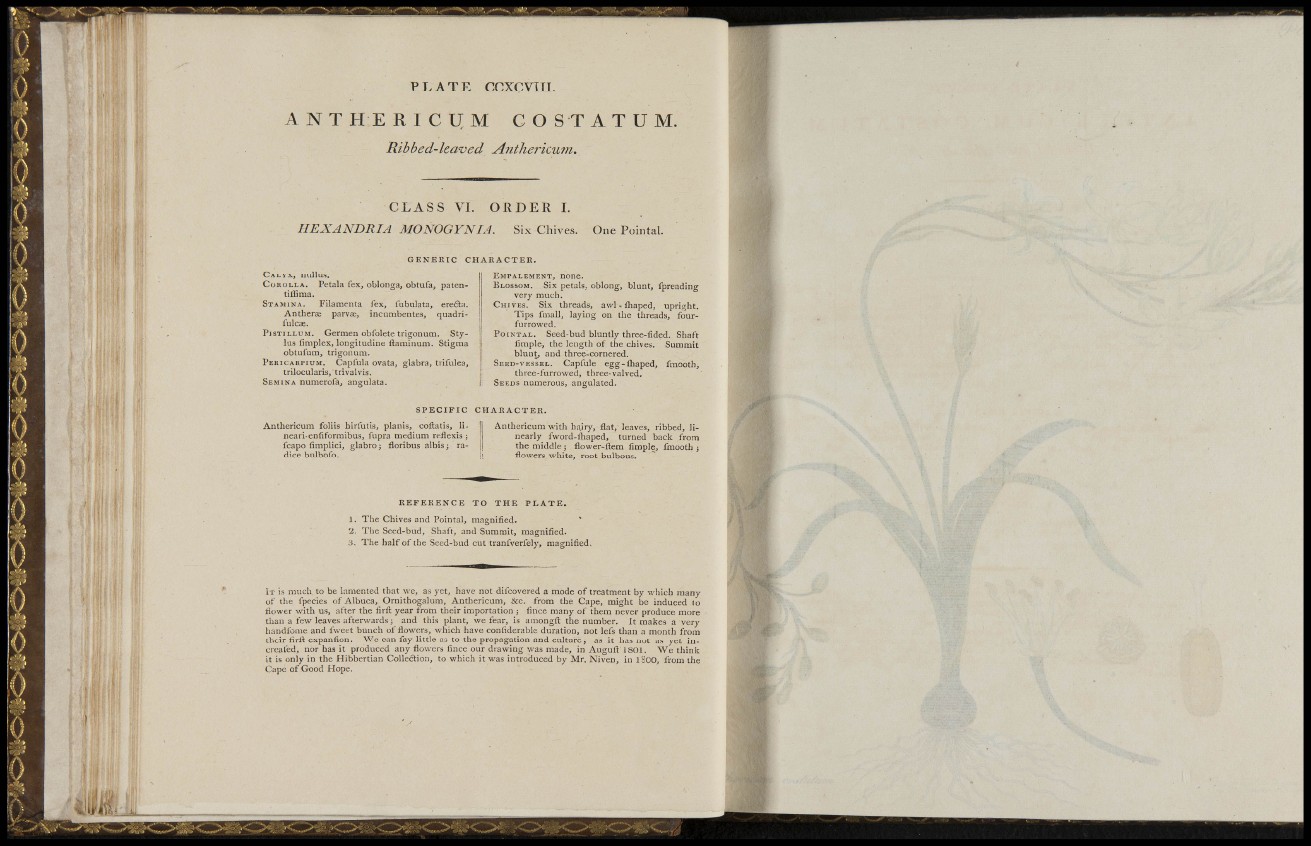
CALYX, nullus.
COROLLA. Pétala fex, oblonga, obtufa, patentillima.
STAMINA. Filameiita fex, iubiilata, erefta.
Anthers; parvae, incumbentes, quadrifulcae.
PJSTILLUM. Germen obfolete t r igonum. Stylas
(implex, longitudine ftaminum. Stigma
obtufum, trigonura.
PERICARPIUM. Caplula ovata, glabra, trifulca,
trilocularis, trivalris.
SEMINA numerofa, angulata.
PLATE CCXÇVm.
A N T H E R 1 C U M C O S T A T U M.
Ribbed-leaved Anthericum.
CLASS VL ORDER L
HEXANDRIA MONOGYNIA. Six Chives. One Pointai.
G E N E R I C CHAKACTER.
EMPALEMENT, none.
BLOSSOM. Six petals, oblong, blunt, fpreading
very much.
CHIVES. Six threads, avvl-iliaped, upright.
Tips fmall, laying on the threads, fourfurrowed.
PoiNTAL. Seed-bud bluntly three-fided. Shaft
fimple, the length of the chives. Summit
b l u n t , and three-cornered.
SEED-VESSEL. Capfule egg-ihaped, fmooth,
three-furrowed, three-valved.
SEEDS numerous, angulated.
S P E C I F I C CHARACTER.
Anthericum foliis hirfutis, planis, coflatis, lineari
enfiformibus, fupra medium re.flexis ;
fcapo limplici, glabro; floribus albis; radice
bulbofo.
Anthericum wi t h hajry, flat, leaves, ribbed, linearly
fword-lhaped, turned back from
t h e middle; flower-ftem fimple, fmooth;
flowers white, root bulbous.
R E F E R E N C E TO THE PLATE.
1. The Chives and Pointal, magnified.
2. The Seed-bud, Shaft, and Summit, magnified.
3. The half of the Seed-bud cut tranfverfely, magnified.
IT is much to be lamented that we, as yet, have not difcovered a mode of treatment by which many
of the fpecies of Albuca, Ornithogalum, Anthericum, &c. from the Cape, might be induced to
flower with us, after the tirfl: year from their importation ; fince many of them never produce more
than a few leaves afterwards; and this plant, we fear, is amongft the number. It makes a very
handfome and fwect bunch of flowers, which have confiderable duration, not lefs than a mont h from
their iirft expanfion. We can fay little as to the propagation and culture; as it has not as yet incrcafed,
nor has it produced any flowers fince our drawing was made, in Auguf t 1801. We think
it is only in the Hibbertian Collection, to which it was introduced by Mr. Niven, in ISOO, from the
Cape of Grood Hope.